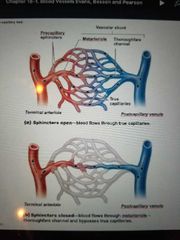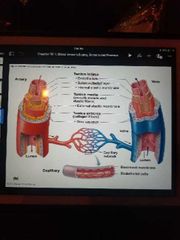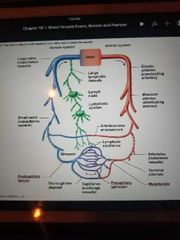![]()
![]()
![]()
Use LEFT and RIGHT arrow keys to navigate between flashcards;
Use UP and DOWN arrow keys to flip the card;
H to show hint;
A reads text to speech;
22 Cards in this Set
- Front
- Back
|
What are blood vessels? |
Delivery system of dynamic structures that begins and ends with the heart. - work with lymphatic system to circulate fluids |
|
|
What are the types of blood vessels? |
Arteries: carry blood away from the heart. Oxygenated except for pulmonary circulation and umbilical vessels Veins: carry blood toward the heart. Deoxygenated except for pulmonary circulation and umbilical vessels of fetus. Capillaries: connect smallest arteries to veins, direct contact with tissue cells, directly serve cellular needs |
|
|
What is a tunic? List them |
Tunic: layer in blood vessels (all arteries and veins). - tunica intima - tunica media - tunica externa * arteries will always have a thicker smooth muscle wall compared to veins, and also have more elastic fibers. * capillaries have an endothelium with sparse basal lamina. |
|
|
Do all vessels consist of a lumen? |
Yes. A lumen is a central blood containing space. Surrounded by a wall (tunic) in arteries and veins. Endothelium: simple squamous epithelium that lines lumen of all vessels. Continuous with endocardium, reduces friction, acts as selectively permeable barrier. Secrete chemicals that dilate or constrict, normally repels blood cells, leukocytes can adhere to the surface. |
|
|
Describe each tunica layer |
1. Tunica intima: innermost layer. Subendothelial layer: connective tissue basement membrane. Found only is vessels larger than 1mm. 2. Intima media: middle layer. Smooth muscle, collagen and elastic tissue. Bulkiest layer responsible for maintaining blood flow and blood pressure. Sympathetic vasomotor nerve fibers innervate this layer, controlling vasoconstriction- decreased lumen diameter and vasodilation- increased lumen diameter. Prevents rupture. Vasomotion- changes in diameter of the blood vessel brought about by smooth muscle. 3. Intima externa: outermost layer. Loose collagen fibers that anchor it to surrounding structures. Provides passage for nerve fibers and lymphatic vessels. Contains VASO VASORUM: system of tiny blood vessels found in larger vessels. Function to nourish outermost external later. |
|
|
What are the three groups that arteries are divided into? |
- Elastic arteries (largest). Conducting arteries: Thick walled with large, low resistance lumen. Aorta, common carotid, subclavian, pulmonary trunk and common iliac arteries. Elastin found in all tunics. Inactive in vasoconstriction. Expand during systole, recoil during diastole which lessens fluctuations in BP: allows for continuous blood flow downstream even between heart beats. - Muscular arteries: medium: distributing arteries: account for most of named arteries. Brachial, femoral, renal and splenic arteries. Have thickest tunica media with more smooth muscle but less elastic tissue. Active in vasoconstriction. - Aterioles (smallest) resistance arteries: larger aterioles contain all 3 tunics and smaller ate are mostly single layer. Thicker tunica media (for diameter) and very little tunica externa. Control amount of blood into capillary beds via vasodilation and vasoconstriction of smooth muscle. |
|
|
What groups are veins divided into? |
- veins (largest) - venules - capillaries (smallest) |
|
|
Describe capillaries |
Exchange vessels: Microscopic vessels, only single RBC can pass through at a time. Walls are just thin tunica media. Pericytes: spider shaped stem cells help stabilize capillary walls, control permeability and play a role in vessel repair. Supply almost every cell except for cartilage, epithelia, cornea and lens of eye. Function: exchange of gases, nutrients, wates, hormones, etc between blood and tissue fluid through the walls of vessels. - consist only of epithelium, the capillary bed is a network of capillary networks. All capillary endothelial cells are joined by tight junctions with gaps called intercellular clefts. |
|
|
What are the types of capillaries? |
1. Continous capillaries: abundant in skin, muscles, lungs and CNS. Continous capillaries of brain are unique: form blood brain barrier, totally enclosed with tight junctions and no intracellular clefts. 2. Fenestrated capillaries: found ina areas involved in active filtration (kidneys), absorption (intestines) or endocrine hormone secretion. Endothelial cells contain swiss cheese like pores called fenestrations which allow for increased permeability. 3. Sinusoidal capillaries: contain macrophages, found only in the liver, bone marrow, spleen and adrenal medulla. |
|
|
What is a capillary bed? |
- Interwoven network of capillaries between aterioles and venules. - microcirculation: flow of blood through bed. |
|
|
What are the two types of vessels in capillary beds? |
1. Vascular shunt: channel that connects arteriole directly with venule, * terminal arteriole that feeds into (metarteriole: intermediate between arteriole and capillary that is continuous with thoroughfare channel (intermediate between capillary and venule) that feeds into postcapillary venule that drains bed. 2. True capillaries: actual vessels involved in exchange, precapillary sphincters regulate flow of blood into capillaries. Branch off metarteriole or terminal arteriole. Blood may go into true capillaries or to shunt. 10-100 exchange vessels per capillary bed. |
|
|
Vascular shunt, precapillary sphincters, true capillaries, metarteriole. Sphincters open and closed. |

|
|
|
Describe veins |
Veins carry blood toward the heart. - Formation begins when capillary beds unite in postcapillary venules and merge into larger and larger veins (when venules converge). Tunica media is thin but tunica externa is thick. Contain collagen fibers and elastic networks. Large lumen and thin walls make veins good storage vessels:l called capacitance vessels: blood reservoirs, because they contain up to 65% of blood supply. - venules: capillaries unite to form postcapillary venules. Very porous, allow fluids and WBCs into tissues. * greater capacity for blood containment than arteries. * have valves! - relatively low BP (~10mmHg) |
|
|
Tunica layers in arteries and veins |

|
|
|
What are the types of veins? Explain each |
- large veins (>10mm) Some smooth muscle in all 3 tunics, thin tunica media with moderate amount of smooth muscle, tunica externa is thickest layer. * venae cavae, pulmonary veins, internal jugular veins and renal veins.
- medium veins (up to 10mm) Thin tunica media and thick tunica externa, tunica interna forms venous valves, varicose veins result from failure of these valves.
- smallest veins: (postcapillary venules) even more porous than capillaries so also exchange fluid with surrounding tissues, most leukocytes emigrate from the bloodstream through venule walls. |
|
|
Picture of large, medium and small veins |

|
|
|
What are vein adaptations? |
Blood pressure is lower in veins than arteries so adaptations ensure return of blood to the heart. Large diameter lumens offer little resistance. - venous valves: prevent backflow of blood, most abundant in veins of limbs. - venous sinuses: flattened veins with extremely thin walls, composed only of epithelium, ex: coronary sinus and dural sinuses of the brain |
|
|
What are varicose veins? |
- Dilated and painful veins due to incompetent (leaky valves). Occur in medium veins (up to 10mm) Thin tunica media and thick tunica externa, tunica interna forms venous valves, varicose veins result from failure of these valves. Stretching and weakening of valves. Blood backflows and futher distends the vessels, their walls grow weak and develop into varicose veins. - Can occur from prolonged standing, obesity, pregnancy. Blood pools in lower limbs, weakening valves. Effects more than 15% of adults. Elevated venous pressure: strain during birth or bowel movement raises intra-abdominal pressure resulting in varacosities in anal veins called hemorrhoids. |
|
|
Describe the types of anastomoses |
- vascular anastomoses: interconnections of blood vessels. - arterial anastomoses: provide alternate pathways (collateral channels) to ensure continuous flow, even if one artery is blocked. Common in joints, abdominal organs, brain and heart. - arteriovenous anastomoses: shunts in capillaries, Ex. Metarteriole-throroughfare channel. - venous anastomoses: so abundant that occluded veins rarely block blood glow. |
|
|
Define flow, pressure and resistance |
Blood flow: (F) volume of blood flowing through vessel, organ or entire circulation in given period. - measured in ml/min. Equivalent to CO for entire vascular system.
Blood pressure: force per unit area extend on wall of blood vessel by blood. - measured in mmHg. Pressure gradient provides driving force that keeps blood moving from higher to lower pressure areas.
Resistance: (R) peripheral resistance: opposition of flow. Amount of friction blood encounters. - 3 sources of resistance: 1. Blood viscosity: thickness/stickiness of blood due to formed elements and plasma proteins. Increased viscosity = increased resistance. 2. Total blood vessel length: longer the vessel, greater the resistance. 3. Blood vessel diameter: greatest influence on resistance. Peripheral resistance. Laminar flow (fluid close to walls moves more slowly than in the middle of tube). |
|
|
Describe the relationship between flow, pressure and resistance |
*** blood flow (F) is directly proportional to BP gradient. If BP increases, blood flow speeds up. *** blood flow is inversely proportional to peripheral resistance (R). If R increases, blood flow decreases. So... F= BP/R. *** R is more important in influencing local blood blood because it is easily changed by altering blood vessel diameter. |
|
|
Systemic blood pressure |
- pumping action of heart generates blood flow, pressure results when flow is opposed by resistance, systemic pressure is highest in aorta and declines throughout pathway. Steepest drop occurs in arterioles. |

